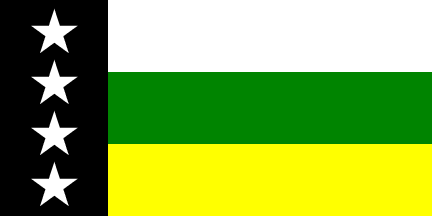 klaus-michael schneider
klaus-michael schneider
Keywords: ecuador | orellana |
Links: FOTW homepage | search | disclaimer and copyright | write us | mirrors

Last modified: 2021-08-26 by  klaus-michael schneider
klaus-michael schneider
Keywords: ecuador | orellana |
Links: FOTW homepage |
search |
disclaimer and copyright |
write us |
mirrors
 image by António Martins-Tuválkin, 19 October 2017
image by António Martins-Tuválkin, 19 October 2017
See also:
Cantons:
Orellana province was established after two decades of social struggle. An
assembly held on 14 June 1984 in the church of Lago Agria proposed the
establishment of a new province, separated from Napo province, on the model of
the call for the creation of Sucumbíos province. His Grace Alejandro Labaka
(1920-1987; apostolic Vicar of Aguarico, 1984-1987) pushed the creation of
Orellana province in a further meeting held on 9 March 1985.
On 2 August
1986, a petition was tabled to the National Congress, requiring the
establishment of two new provinces, Sucumbíos and Orellana. Sucumbíos was
eventually established in 1989.
On 5 March 1987, volcano Reventador
exploded and an earthquake hit the region, causing the total isolation of
Francisco de Orellana canton; this prompted the inhabitants to reactivate their
call for the establishment of a province. The Alejandro Labaka Committee was
formed on 2 August 1987 in Coca.
In 1997, the social pressure exerted by the
municipalities of Orellana and Aguarico reopened the
case. The Special Commission of the Internal Limits of the Republic informed on
13 April 1998 the National Congress of its validation of the proposed Amazonas
Province. The process was delayed once after the Peruvian Consulate had stated
that Amazonas was not a suitable name for the new province. To settle the
dispute, three new names were proposed, Coca, Orellana and Quijos.
Orellana province was eventually established on 26 July 1998 by an Executive
Decree published in the official gazette, No. 372. Its capital is the town of
Francisco de Orellana, aka El Coca.
http://www.gporellana.gob.ec/
Province website
Ivan Sache, 18 September 2018
The flag is composed of three horizontal stripes.
The white stripe
symbolizes the peaceful Amazonian people.
The green stripe represents the
rich biodiversity of the extensive Amazonian forest.
The yellow stripe
represents gold, part of the resources of the province.
The black, vertical
stripe represents the resources in oil extracted from the Amazonian soil.
The
four stars symbolize the four cantons that constitute the province.
http://www.gporellana.gob.ec/simbolos-patrios-provinciales/
Ivan Sache, 18 September 2018
v.gif) image by Jens Pattke, 28 September 2008
image by Jens Pattke, 28 September 2008
At the pages <www.turismorellana.gov.ec>,
one finds the description of the Coat of Arms of the Ecuadorian
province of Orellana. I have found the image of the provincial
arms at a tourist brochure.
Jens Pattke, 28 September 2008
Translated from this web site:
"Based on a concept both ancestral and current. Made of a
central triangle meaning a lance head as well as an oil derrick.
In base, the flag of the Province of Orellana supports the
symbols. On the left side of the triangle, the flags of the
Cantons of Francisco de Orellana and Loreto; on the right side of
the triangle, the flags of the Cantons of Aguarico and Joya de
los Sachas. The cantonal flags are hoisted on natives' lances
made of "chonta"* decorated with "chambira"**
threads tied to them. Inside the triangle are placed the
following symbols:
- in upper point, an oil derrick, symbolizing the resources from
our subsoil;
- in the lower left part, a triangle of light colour,
representing the exuberance and biodiversity of our Amazonian
forest; also pictured a Waorani*** together with a monkey, a
"chonta"* and a tattoo on a lance;
- in the lower right part, a celeste triangle with a tug boat,
representing navigation and trade with the neighbouring
countries, Peru and Brazil, and worldwide via the river Napo****,
tributary of the Amazon. Also recalling that we owe a genuine
treasure of water resource;
- in the middle of the main triangle, a sun in the center,
crossed by a green arc and a red parrot with its wings spread
over the arc, the arc being charged with four stars recalling the
four cantons forming the Province of Orellana;
- in the lower central part, an open book meaning science,
education, virtue and work, together with a cross recalling us
Christian love and solidarity.
The shield is crowned by the Ecuadorian Tricolour, with the
writing "1998 PROVINCIA DE ORELLANA 2001" symbolizing
and recalling our position of sentinels of the Amazonian border.
The name of the designer is Mrs. Dorix Cortéz, who has been
teaching her knowledge to children and youth for more than 20
years."
* different species of palms, which have been important to the
livelihood of indigenous peoples in the Amazon region since
ancient times: <www.exploringecuador.com>.
** Astrocayum chambira Burret, another palm of
significance for the indigenous peoples
*** a.k.a Huaorani or Waos. Some 4,000 individuals living on some
700,000 ha, constantly endangered by oil prospection and illegal
logging.
**** the first tributary of Amazon explored by the Spaniards, led
by Francisco de Orellana (1540-1541). Orellana (1511-1546)
founded Guayaquil and baptized the Amazon.
Ivan Sache, 29 September 2008